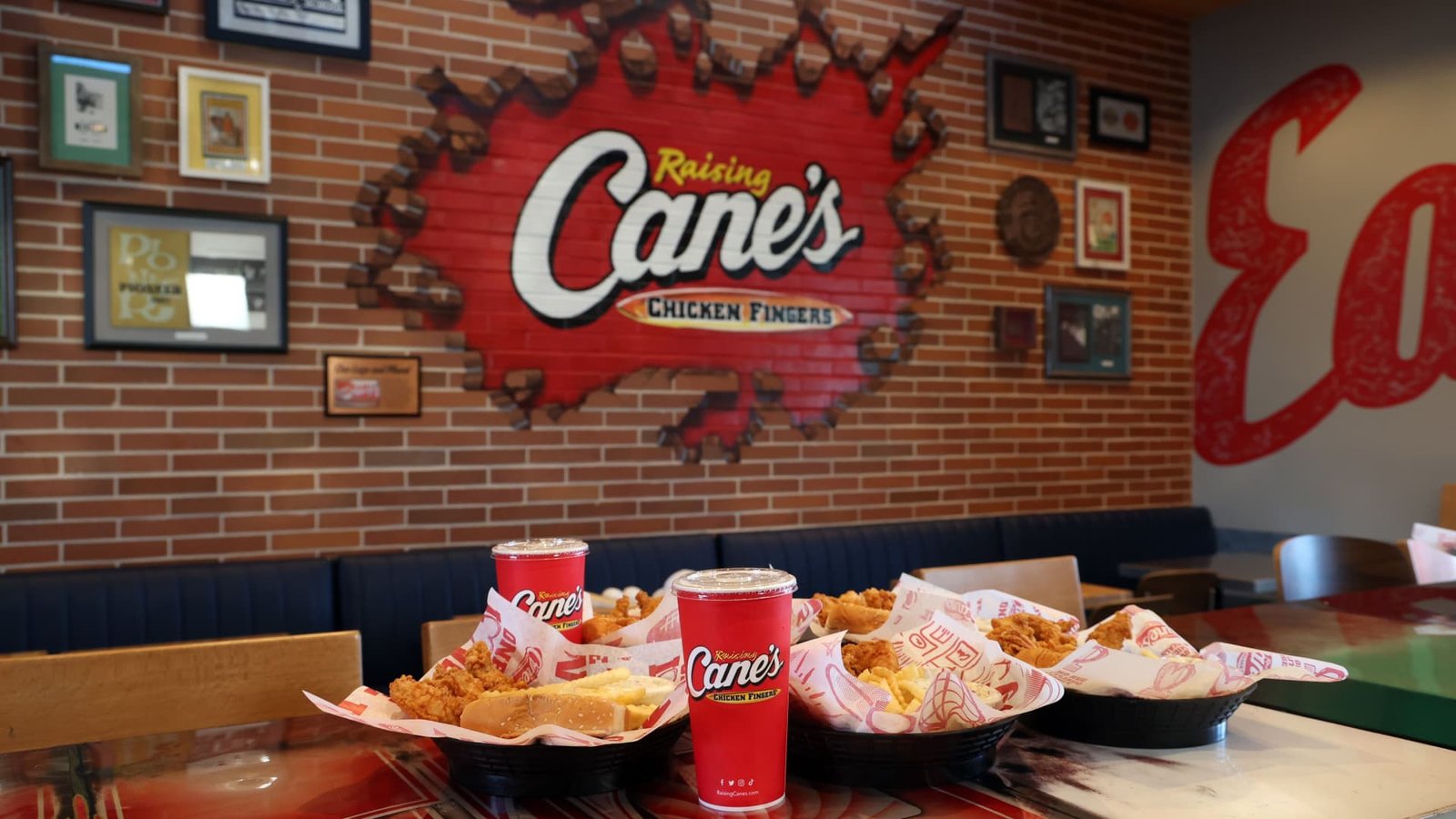With a simple menu and company-owned restaurants, Raising Cane’s has quietly surpassed KFC in annual U.S. sales, becoming the third-largest chicken chain in the country.
The accomplishment follows a recent winning streak for the 28-year-old company, which has spent the last decade expanding outside its home bases in Louisiana and Texas. Its restaurant footprint has grown to more than 900 locations, up from just over 500 in 2020. Last year, it opened 118 restaurants. About 100 are expected to open this year, with another 200 or so in the development pipeline.
Cane’s told CNBC that its system sales rose to $5.1 billion last year, more than double its total in 2021. Last year’s total was lifted by a 10.8% increase in traffic, even as consumers pulled back their overall restaurant spending. Cane’s trails only Chick-fil-A and Restaurant Brands International’s Popeyes in U.S. sales.
But Cane’s founder Todd Graves has even bigger ambitions for the chain he started at age 24. He has said that he wants Raising Cane’s to become a top 10 restaurant chain, with more than $10 billion in annual sales. The chain is ranked 18th – up 10 spots from a year earlier – on Technomic’s list of U.S. restaurant brands based on 2024 system sales.
Displays and signage are seen at Raising Cane’s on March 27, 2024 in Alhambra, California.
Phillip Faraone | Getty Images
Cane’s is inching closer to Graves’ goal every day. Last year, the chain reported its first $1 billion quarter, and its speedy expansion should further lift sales. It expects to operate nearly 1,000 restaurants by the end of 2025.
“All indicators say that we should get there before the end of this decade,” said AJ Kumaran, who shares the title of co-CEO with Graves. “We’re climbing the ladder slowly, but we’re humble about it.”
Of course, in a crowded space where major players like Popeyes, Chick-fil-A, McDonald’s and even Taco Bell are competing for diners craving chicken, sustained growth is not guaranteed. Consumers could also continue watching their spending in an uncertain economy.
founded Raising Cane’s in August 1996, in part using money from working in an oil refinery and fishing for sockeye salmon in Alaska. The name came from his labrador retriever, Raising Cane. (He’s continued using the name for every subsequent dog he owns; Raising Cane III, born in 2017, is the latest.)
The first Cane’s location, which still exists, opened at the North Gates of Louisiana State University in Baton Rouge. Then came a second restaurant, followed by many more.
In the nearly 30 years since Cane’s founding, its menu hasn’t budged: chicken fingers, crinkle-cut fries, Texas toast, coleslaw and the all-important trademark sauce. Even its sandwich is simply three chicken fingers with lettuce and Cane’s sauce on a bun.
A view of the food at the Food Network New York City Wine & Food Festival with chef Nick DiGiovanni, presented by Capital One and Raising Cane’s Chicken Fingers, celebrating NYCWFF tickets going on sale and the June 27th opening of Raising Canes’ flagship Times Square store on June 21, 2023 in New York City.
Slaven Vlasic | Getty Images
Cane’s doesn’t plan on changing that recipe anytime soon.
“We do not get into value play. We do not get into limited-time offers. When our customers pull into the drive-thru or walk through the doors, they immediately know what to expect,” Kumaran said.
Sandra, 60, a home health aid in New York City, said she eats a kid’s meal from Raising Cane’s once a week, calling it a great value for the price.
“I like Popeyes, but I love Raising Cane’s,” she told CNBC after a recent afternoon visit to the city’s Astor Place location, adding that it’s “just good food.”
Kumaran, a seasoned restaurant executive, joined Cane’s as its chief operating officer in 2014 after holding similar roles at restaurant company Gourmet Gulf LLC in Dubai, United Arab Emirates, and Old Country Buffet owner Buffets Inc.
Three years later, Cane’s named Kumaran co-CEO, just in time for a massive boom in fast-food chicken chains.
Chick-fil-A was finally expanding past its Southeastern stronghold, opening its first Manhattan location in 2015 as part of a nationwide expansion plan. Four years later, Popeyes unveiled its first chicken sandwich sold nationwide, kicking off the so-called chicken sandwich wars and selling out of the initial launch quickly. Upstarts like Dave’s Hot Chicken, which recently sold a majority stake to Roark Capital for nearly $1 billion, were in their early days.
While the boom in chicken at fast-food restaurants may seem like a recent trend, the obsession has been a long time coming.
Since 1960, U.S. consumption of chicken has grown steadily. In 2025, the national per capita consumption is expected to hit 104 pounds, up more than 25% over the last 15 years, according to data from the National Chicken Council.
“I think it’s a change in people’s diets and their mindsets,” said Andrew Sharpee, co-leader of AlixPartners’ restaurants, hospitality and travel practice. “It’s still a cheaper alternative than where beef prices are. It’s easier on the wallet, and it’s easier for these companies to execute.”
Plus, chicken offers variety, from the breading to the seasoning to the sauces used for dipping. Diners can visit Wingstop if they want wings, Popeyes for crunchy fried chicken or Chick-fil-A for boneless grilled nuggets.
“It’s come a long way, right? Chicken is not this heavily processed, frozen-to-fryer product. It’s fresh, battered in stores,” Sharpee said.
In recent years, other chicken players have slowly expanded their menus with limited-time offers and other draws for diners. Chick-fil-A has been leaning into seasonal drinks, like its Peach Milkshake. Popeyes is selling Chicken Wraps for a limited time this summer.
And KFC’s menu has become sprawling, from bowls to waffles — a trend that could have helped Raising Cane’s and its simple offerings gain ground.
In the first quarter, KFC’s U.S. same-store sales shrank 1%, its fifth straight quarter of declines. The ubiquitous fried chicken restaurant now ranks as the fifth-largest chicken chain, trailing both Cane’s and Wingstop by U.S. sales, according to Technomic data.
McDonald’s McCrispy Strips to Taco Bell’s sold-out Crispy Chicken Nuggets. But Cane’s isn’t sweating the extra competition.
“We are the chicken finger meal experts. We don’t think anybody can do it better than us at the scale that we do,” Kumaran said. “I think for us it’s not a fad. For us, it’s a lifestyle.”
Cane’s laser focus on its chicken fingers has helped it become a chicken behemoth.
“I do think simplicity is kind of the starting point,” said R.J. Hottovy, head of analytical research for Placer.ai, which uses anonymized location data to estimate overall visits to retail and restaurant locations. “From a drive-thru perspective, they’re one of the most efficient operators in the business. Really, Chick-fil-A is the only one that’s even close to that.”
Hottovy compared Cane’s success to that of another fast-growing chain, once known for its long lines: Chipotle.
“Maybe you saw a long line out the door at Chipotle, but you were willing to wait for it because you can get through the line quickly,” he said. “And I think we’ve got a similar, similar phenomenon going on with Raising Cane’s and some of the other hot chicken chains where sometimes there’s long lines, but they’ve set up the system to move quickly.”



